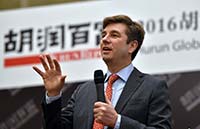

Three strands to the slowdown in china need to be looked at individually and together
'In the long run we are all dead." There are varying interpretations of the famous words, written by the economist John Maynard Keynes in a tract written almost 90 years ago. Some interpret them as meaning we must seize opportunities while we can because time and tide wait for no one. But I do not think Keynes meant the long term is useless. Rather, he was pointing out its relationship with the short term.
Chronic sickness in an economy is rarely fatal, but when such sickness is accompanied by short-term pain it often is. The Chinese economy may have entered its current bleak state as long-term and short-term dynamics coalesced.
The National Bureau of Statistics said that in the third quarter, GDP grew 7.4 percent, continuing its downward trend. The International Monetary Fund has lowered its forecast of growth for the year to 7.8 percent, and the World Bank had lowered its forecast to 7.7 percent. Little surprise then if China's GDP growth this year is below 8 percent.
That would be the slowest economic growth in China in the past 12 years. In 2009, even as the global economy was contracting 0.57 percent, China's economy grew 9.2 percent. This year the global economy is expected to grow 3.28 percent as China's growth drops below 8 percent, two percentage points lower than its average growth of 10.01 percent from 1980 to 2011.
There are three strands to this slowdown: structural, cyclical, and the two combined.
Reasons for the structural slowdown are numerous. Population growth and demographic changes are pushing China's demographic dividend to diminish or even disappear; As financial and other policy reforms have been successfully implemented, the systematic delivery of bonuses for growth has diminished; The rises in international prices of resources and in wages have weakened the cost advantage of long-term economic growth; The structural imbalance between investment and consumption, urban and rural, the real economy and the virtual economy has not been alleviated, it has in fact deepened.
The cyclical slowdown is the result of a lack of short-term demand, mainly caused by the following factors. First is the impact of the debt crisis on the real economy as China has faced great pressure to keep overseas demand going. The second is connected with progress in economic restructuring, in which China faces the pressure of growth in domestic demand.
The third factor is the cyclical decline of momentum piled on by long-term high growth of 10 percent. The need in China for its economy to slow down has become increasingly strong.
China needs to confront these complex circumstances by identifying a core strategy out of all the apparent contradictions and uncertainties and take steps that are at once concrete and balanced.
There is no such thing as a cure-all solution, and decision-makers need to give priority to certain things even as they let others go. If China cannot quickly resolve structural slowdowns and cyclical slowdowns simultaneously, it should focus on one. Structural slowdowns are caused by long-term structural imbalances, and a short-term response will not quickly change long-term risk. So at present we should focus on defusing the cyclical slowdown.
 Top 10 Chinese internet companies
Top 10 Chinese internet companies
 Fun time for children at international toy expo in Beijing
Fun time for children at international toy expo in Beijing
 Huawei launches new smartphone P9 in Vietnam
Huawei launches new smartphone P9 in Vietnam
 Top 10 box office movies on China market in H1
Top 10 box office movies on China market in H1
 Woman resigned from high salary job to make notebooks
Woman resigned from high salary job to make notebooks
 Hurun publishes Global Chinese Big Philanthropy Report 2016
Hurun publishes Global Chinese Big Philanthropy Report 2016
 Top 10 new economy issues in China
Top 10 new economy issues in China
 Wetland helps preserve ecology of Dianchi Lake
Wetland helps preserve ecology of Dianchi Lake

